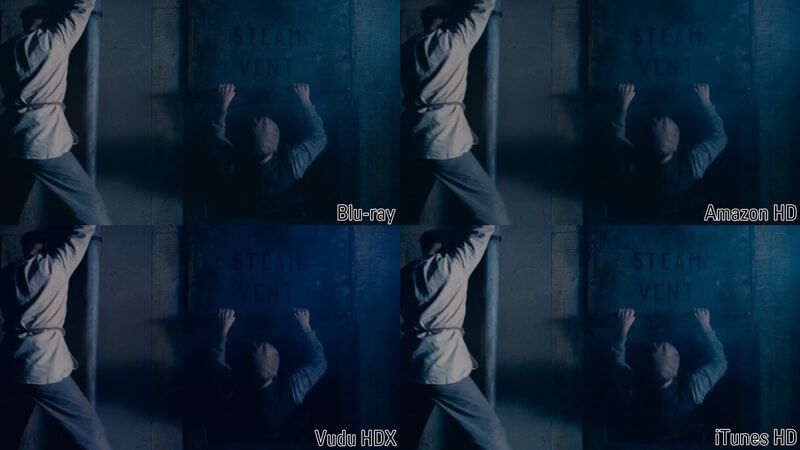Have you ever settled in for a movie night, only to be met with a grainy, pixelated image and choppy sound? You’ve probably encountered a webrip. But what exactly is a webrip, and how does it compare to a crystal-clear Blu-ray disc? This guide dives into the world of digital video formats, revealing the differences between webrips and Blu-rays and helping you choose the best viewing experience.

Image: www.vidmore.com
Imagine this: You’re excited to watch a new movie release. You find it online, but there are two options, one labeled “WebRip” and the other “Blu-ray.” Which one do you choose? You might find yourself wondering, “What does ‘WebRip’ even mean, and is it better or worse than a Blu-ray?” Navigating the digital video landscape can be confusing, especially with so many acronyms and technical terms thrown around. This article is your roadmap, giving you the knowledge to understand the intricacies of webrips and Blu-rays so you can make informed decisions about your viewing experience.
Unpacking the Terms: What are WebRips and Blu-rays?
Before we compare the two formats, let’s define what they actually are.
WebRips: The Downloaded Download
The name gives it away: Webrips are copies of films that are ripped from a digital source, often a streaming service or online platform, and then compressed to make them easier to share and download. They’re essentially movies captured directly from a screen, which can lead to certain inconsistencies and drawbacks.
Blu-ray: The High-Definition Standard
Blu-ray discs are the current standard for high-definition video content. They offer a superior picture quality, higher resolution, and more detailed sound than webrips. The information on a Blu-ray disc is encoded with specialized compression technology that prioritizes quality over file size.

Image: www.leawo.org
What’s the Difference: A Detailed Breakdown of WebRip vs. Blu-ray
The key difference between webrips and Blu-ray discs lies in their source, compression methods, and overall quality.
Source: Where the Video Came From
- WebRip: Their source is typically a digital stream from a service like Netflix, Hulu, or Amazon Prime Video. The video is “ripped” using software that captures the stream’s output.
- Blu-ray: They are created directly from a high-resolution master copy of the film, usually in a studio setting.
Compression: How the Video Is Shrunk
- WebRip: To make them easier to share and download quickly, webrips are often heavily compressed using lossy compression algorithms. This compression sacrifices some video quality to reduce file size.
- Blu-ray: Blu-ray employs specialized lossy compression algorithms that are designed to preserve high fidelity audio and video. They prioritize quality over aggressively shrinking file size.
Quality: How the Video Looks and Sounds
- WebRip: The quality of webrips can vary greatly depending on the stream’s quality, compression level, and the encoder’s skill. They often exhibit artifacts like blockiness, pixelation, and banding, which are visual imperfections that detract from the viewing experience. Sound quality can also suffer, with noticeable compression artifacts, especially with dialogue.
- Blu-ray: Blu-ray discs offer significantly better quality with higher resolution, richer colors, and detailed sound. They are designed to provide a visually stunning and immersive cinematic experience, particularly on larger screens with high-quality display technology.
The Downsides of WebRips: Why Blu-ray Reigns Supreme
Webrips may seem alluring due to their accessibility and file size, but they come with several downsides that can significantly impact your viewing pleasure.
Quality Issues: The Visual and Audio Trade-offs
- Pixelation and Blockiness: The heavy compression required for webrips often leads to noticeable pixelation and blockiness, especially in action sequences and scenes with lots of detail.
- Color Banding: Compression can introduce unnatural banding, where smooth transitions between colors become visible as distinct stripes.
- Sound Degradation: Compression can distort audio, making dialogue muffled or unclear, and music and sound effects lack the dynamic range and detail of a Blu-ray.
Legal and Ethical Concerns: A Digital Dilemma
- Copyright Infringement: Distributing and downloading webrips without authorized licenses can violate copyright laws, leading to legal repercussions.
- Malware Risk: Downloading from untrusted sources carries the risk of malware infection, potentially harming your computer or revealing your personal information.
When WebRips Can Be Acceptable: Exploring the Exceptions
While Blu-rays generally offer a superior experience, there are specific situations where webrips can be a suitable option:
Low Bandwidth Connections: Bridging the Digital Divide
- Streamlining Streaming: In areas with limited internet speed, webrips can be an alternative for watching movies online. Their smaller file sizes load faster, making for a smoother streaming experience.
Previewing Content: A Sneak Peek
- Pre-Purchase Exploration: Webrips can allow you to quickly preview a movie before purchasing the Blu-ray, especially when you want to see if its content aligns with your preferences.
Choosing the Right Format: A Guide to Better Movie Nights
To make the best choice for your viewing needs, consider the following factors:
Picture Quality Matters: Prioritizing Image Fidelity
- High-Resolution Viewing: If you enjoy watching movies on a large screen or a high-resolution display, Blu-ray offers the clear picture quality to do them justice.
- Screen Size and Resolution: Avoid webrips on larger screens as their quality shortcomings become more obvious.
Audio Experience: Immerse Yourself in Sound
- Surround Sound Systems: Blu-rays deliver a more immersive audio experience with detailed soundtracks that can take advantage of multi-channel surround sound systems.
- Sound Quality Sensitivity: If you highly value audio quality, a Blu-ray is the way to go.
Legal and Ethical Considerations: Choosing the Right Path
- Legal Streaming Services: Support creators by subscribing to legitimate streaming services like Netflix, Hulu, Disney+, and Amazon Prime Video. These services offer high-quality streaming and are a legal way to enjoy movies.
- Avoiding Piracy: Remember that downloading webrips illegally can have serious legal consequences.
Webrip Vs Bluray
Conclusion: The Power of Informed Choices
By understanding the key differences between webrips and Blu-rays, you can navigate the digital video landscape with confidence. Webrips may be convenient for previewing content or streaming on low-bandwidth connections, but Blu-rays offer the best possible quality in terms of picture and sound. Ultimately, the best format depends on your individual needs and preferences. Make your choices consciously, prioritizing quality, ethical practices, and the future of filmmaking.
Let’s continue the conversation! Share your thoughts and experiences with different video formats in the comments below.





